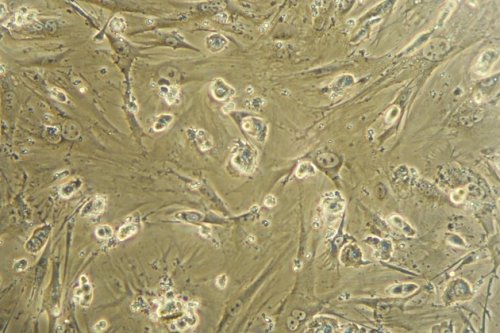Scientists said Tuesday they had transformed age-worn cells in people over 90 -- including a centenarian -- into rejuvenated stemcells that were "indistinguishable" from those found in embryos.
The technical feat, reported in the peer-reviewed journal Genes & Development, opens a new path toward regenerative medicine, especially for the elderly, the researchers said.
"This is a new paradigm for cell rejuvenation," said Jean-Marc Lemaitre, a researcher at the Institute of Functional Genomics at the University of Montpellier and the main architect of the study.

"The age of cells is definitely not a barrier to reprogramming," he told AFP by phone.
That human embryonic stem cells (ESC) can potentially become any type of cell in the body has long held out the tantalizing promise of diseased organs or tissue being repaired or replaced with healthy, lab-grown cells.
But the leap from theory to practice has proven difficult, and fraught with ethical and moral concerns because any such procedure requires the destruction of a human embryo.
The discovery in 2007 that it is possible to coax certain adult cells back into their immature, pre-specialised state has fuelled renewed efforts to generate brand new muscle, heart or even brain cells, this time from raw material provided by the patient.
Experiments to date, however, have shown that the usual chemical recipe for generating these so-called induced pluripotent stem cells (iPSC) works less well or not at all with the elderly and very elderly -- precisely the cohort with the most to gain from regenerative therapies.
The barrier was cellular senescence, a natural process linked to ageing that can trigger cell death when certain mechanisms within the cell become too degraded to function properly.
Lemaitre and colleagues decided to alter the standard genetic starter kit used to generate adult stemcells by adding two new ingredients -- known as transcription factors -- called NANOG and LIN28.
Experiments with human subjects ranging in age from 74 to 101 showed that the new cocktail worked.
Several critical markers of ageing in cells were "reset", including the size of telomeres, the tiny protective caps found on the ends of chromosomes that wear down with age, the researchers reported.
Telomeres and telomerase, the enzyme that control them, are a key agent in longevity.
Every time a cell divides, the telomeres get worn down a little bit. The enzyme's job is to partially rebuild them. Eventually, when the telomeres are worn beyond repair, a cell dies.
Gene expression profiles, levels of oxidative stress, and the metabolism of the cell's energy-generating mitochondria were all likewise rejuvenated, according to the study.
"The age markers in the cell has been erased," said Lemaitre. "The iPSC stemcells we got can produce functional cells of all types with a capacity to proliferate and enhance longevity."
By reversing the age-altered physiology of the cells, he added, the new reprogramming technique "may constitute an optimal strategy for developing cell-based therapies for aged patients."
A large gap remains between this "proof-of-concept" study and therapeutic applications, the researchers cautioned.
And recent experiments with mice suggests that generating adult stemcells may yet face unexpected barriers.
Certain kinds of iPSC may be rejected by the immune system even if they are derived from the same organism, the experiments showed.
<한글기사>
고령노인 체세포 환원성공, 재생의학 새길열어
100세를 포함한 고령 노인들의 체세포를 배아줄기세포와 구분할 수 없을 정도의 원시줄기세포로 환원시키는 방법이 개발됐다.
2007년 일본연구팀이 체세포에 4가지 유전자를 주입, 배아줄기세포와 유사한 유도만능줄기세포(iPS)로 역분화시키는 기술을 개발해 재생의학 연구에 널리 활용되고 있으나 나이가 아주 많은 노인의 체세포는 iPS로의 환원이 잘되지 않는 것으로 알려져 있다.
프랑스 몽펠리에 대학 기능유전체학연구소의 장-마르크 레메트르(Jean-Marc Lemaitre) 박사는 74-101세 노인들의 체세포에 역분화에 필요한 유전자 외에 두 가지 전사인자(NANOG, LIN28)를 추가로 주입해 완전한 iPS로 역분화하는 데 성공했다고 발표했다.
이는 세포의 연령이 체세포 역분화에 장애가 될수 없음을 보여주는 것으로 노인들을 위한 재생의학에 새 길을 열어 주게 될 것이라고 레마트르 박사는 말했다.
레마르트 박사는 두 전사인자의 주입으로 고령노인들의 체세포는 나이를 먹을수 록 닳아 짧아지는 염색체의 말단부인 텔로미어의 길이를 포함해 세포의 노화를 나타 내는 핵심적인 특징들이 "재설정"(reset)됐다고 설명했다.
세포가 한 번 분열할 때마다 텔로미어는 짧아지며 텔로메라제라는 효소가 부분 적으로 텔로미어를 재생시키기는 하지만 텔로미어가 수리 불가능할 정도로 닳게 되면 세포는 죽는다.
이 밖에도 전사인자의 주입으로 유전자 발현의 강도, 산화 스트레스의 수준, 세포 안의 에너지를 만드는 발전소 격인 미토콘드리아의 활동 등도 젊어졌다.
한마디로 "세포의 모든 노화표지가 지워졌다"고 레마르트 박사는 말했다.
이 연구결과는 과학전문지 '유전자와 발달(Genes & Development)' 최신호에 실렸다.





![[KH Explains] No more 'Michael' at Kakao Games](http://res.heraldm.com/phpwas/restmb_idxmake.php?idx=644&simg=/content/image/2024/04/28/20240428050183_0.jpg&u=20240428180321)




![[Grace Kao] Hybe vs. Ador: Inspiration, imitation and plagiarism](http://res.heraldm.com/phpwas/restmb_idxmake.php?idx=644&simg=/content/image/2024/04/28/20240428050220_0.jpg&u=)








